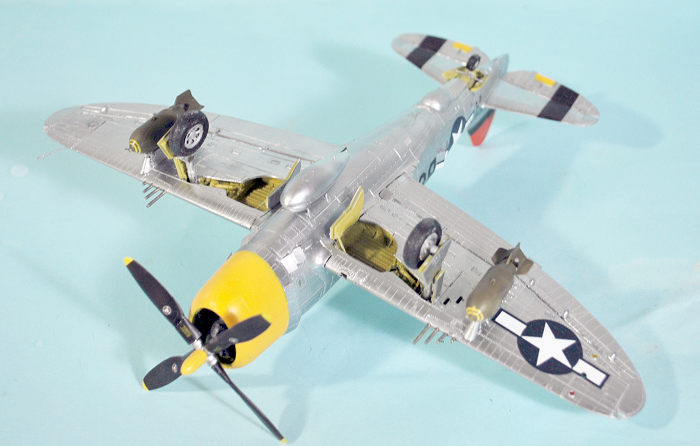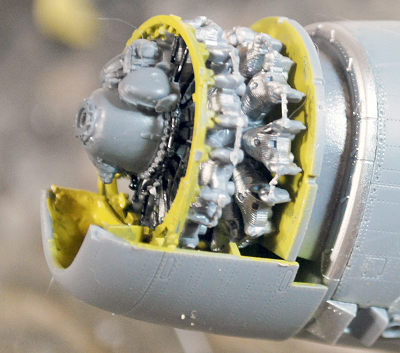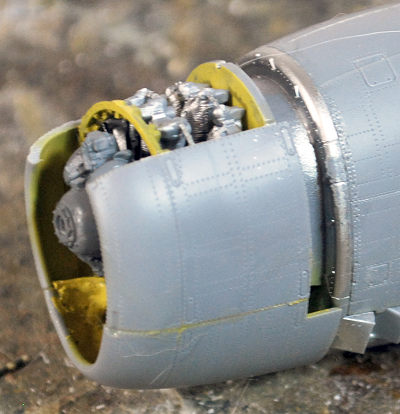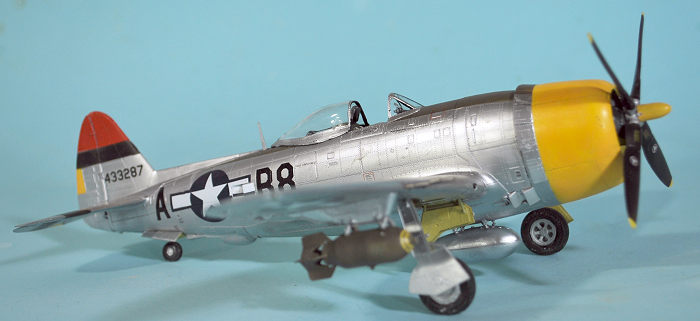
| KIT #: | 48023 |
| PRICE: | $59.00 |
| DECALS: | Two options |
| REVIEWER: | Tom Cleaver |
| NOTES: | Mr.Color super metallic paint |

| HISTORY |
The Republic P-47D-30, which appeared in the ETO during the fall of 1944, and was prodced at both the Farmingdale and Evansville factories, was the first Thunderbolt sub-type to have the underwing dive brakes that prevented the airplane hurtling on into uncontrollable compressibility applied to the airframe at the factory. With this change, the P-47 became an airplane pilots could throw around in air combat without fear.
 A visual clue
for the P-47D-30 was that most were fitted with the extended dorsal fin that
increased directional stability that had been adversely affected by cutting down
the rear fuselage of the “razorback” Thunderbolt to cater for the clear plastic
“bubble” canopy that vastly increased polit visiblity. The P-47D-30 was also
frequently equipped with the Curtiss-Electric asymmetric paddle blade prop,
which gave enhanced performance at all altitudes but most particularly the lower
altitudes the Thunderbolt now operated at as it became the primary USAAF
fighter-bomber in the ETO and MTO.
A visual clue
for the P-47D-30 was that most were fitted with the extended dorsal fin that
increased directional stability that had been adversely affected by cutting down
the rear fuselage of the “razorback” Thunderbolt to cater for the clear plastic
“bubble” canopy that vastly increased polit visiblity. The P-47D-30 was also
frequently equipped with the Curtiss-Electric asymmetric paddle blade prop,
which gave enhanced performance at all altitudes but most particularly the lower
altitudes the Thunderbolt now operated at as it became the primary USAAF
fighter-bomber in the ETO and MTO.
Colonel Joe Laughlin and the 362nd Fighter Group:
Joe Laughlin joined the Air Corps in 1939 - after getting his private pilot license in 1937 - following graduation from North Texas University. He received his wings and orders to Hawaii to join the 18th Pursuit Group at Wheeler Field in 1940. Assigned to the 19th Pursuit Squadron, he was given the job of teaching aircraft recognition; one of his students was 2nd Lieutenant Francis Gabreski.
Following the Pearl Harbor attack, Laughlin became squadron commander of the 45th Pursuit Squadron in the group. In April 1943, he received orders to join the newly-formed 362nd Fighter Group at Westover Field, Massachusetts. Group commander Colonel Morton Magoffin assigned him as commander of the 379th Fighter Squadron. The group finally was issued its own P-47 Thunderbolts in June.
The 362nd went to England in November 1943, assigned to the Ninth Tactical Air Force. They began operations in Febrary 1944, flying dive bombing missions over France and also flying escort missions for the Eighth Air Force. Laughlin had group artist Captain George Rarey, a commercial artist before the war, paint his noseart, a pink elephant done in “Dumbo” style, with the plane receiving the name “Five By Five” to commemorate Laughlin’s stocky build. The artwork was painted on the left side panel of the engine cowling. Laughlin would go through no fewer than 11 P-47s, taking that cowling panel to the next airplane and having his ground crew paint “appropriate surrounding colors.”
 The group went
to France in June 1944, engaged in the Battle of Normandy. On August 10, Colonel
Magoffin was shot down and became a POW. Laughlin, by then Deputy Group
Commander, took his place as Group Commander. He led the 362nd for the rest of
the war.
The group went
to France in June 1944, engaged in the Battle of Normandy. On August 10, Colonel
Magoffin was shot down and became a POW. Laughlin, by then Deputy Group
Commander, took his place as Group Commander. He led the 362nd for the rest of
the war.
On August 25, 1944, the group flew missions against the port of Brest. What was identified as a German light cruiser was found in the harbor and attacked with near misses. In the last mission of the day, Laughlin led the 377th squadron in an attack on the cruiser. He later recalled that “the sky was black with ack-ack fired f rom the ships” in the harbor. His thousand-pound bomb hit the stern, causing a tremendous explosion. The ship began sinking from Laughlin’s deathblow.
In reality, there was no German warship in the harbor. Laughlin and the 362nd had attacked the incomplwete and badly-damaged French battleship Clemenceau, which the Germans were planning to move that night and sink to block the harbor. The 362nd received the first of two Presidential Unit Citations for this action.
In December 1944, Laughlin got his 11th P-47, P-47D-30-RE, serial 44-33287. He had the plane’s cowling painted yellow, the indentification color for the 379th FS. He flew the plane through to the end of the war.
In 2007, the National Museum of the Air Force restored a P-47D-40-RE, which was painted as Laughlin’s last wartime mount.
| THE KIT |
MiniArt released this P-47D-30-RE kit this past February. The primary difference between this kit and the earlier P-47D-25-RE is that the cockpit floor is not corrugated, the fuselage hal;ves are molded with the extended dorsal fin, and the prop provided is the Curtiss-Electric Asymmetrical paddle blade.
Decals are provided for “Torrid Tessie” of the 350th Fighter Group’s 346th Fighter Squadron in Italy in 1945, and Look, No Hands” of the 405th Figher Group’s 509th Fighter Squadron, based in Germany in the Spring of1945.
| CONSTRUCTION |
 Several
YouTube Muddling Gnus have recently concluded that the MiniArt P-47D is a “putty
monster” with poor fit requiring lots of putty which results in loss of the
beautiful surface detail, making it nearly “unbuildable.” Like most YouTube
Gnus, the problem is actually that they are ten-thumbed ham-handed muddlers, as
I noticed watching one of their videos. The Gnus are wrong.
Several
YouTube Muddling Gnus have recently concluded that the MiniArt P-47D is a “putty
monster” with poor fit requiring lots of putty which results in loss of the
beautiful surface detail, making it nearly “unbuildable.” Like most YouTube
Gnus, the problem is actually that they are ten-thumbed ham-handed muddlers, as
I noticed watching one of their videos. The Gnus are wrong.
The MiniArt
P-47D kits can easily be assembled with no putty or filler anywhere, by any
modeler willing to take the time to clean up mating surfaces on parts, test fit,
and then assemble carefully. In other words, “some modeling skill required.”
There is one area where a deviation from the assembly sequence in the instructions will make the job easier and always correct. That is in assembling and attaching the engine and the four-panel cowling.
What I have discovered works in building three of these kits so far is that if I glue the rear bulkhead of the engine compartment to the front of the fuselage, then assemble the engine, starting with the rear row of cylinders, moving forward to the crankcase and the magnetos, there is no chance of misassembling the engine. Then attache the front cowling frame.. Then attach the lower cowling panel, followed by the two side panels, and finally the top panel. I sand the mating edges of these parts to insure they are flat and there are no sprue nubs. Then wrap the cowling with a rubber band and after ensuring everything is properly aligned, let it set up for an hour. Then remove the rubber band and attach the cowling flaps.
| COLORS & MARKINGS |
Recently, a friend recommended the new lacquer-base metal paints recently released by Mr Color, the “Super Metallic 2". I purchased some the last time I was over at Burbank House of Hobbies. This paint is fantastic. I am totally sold on it.
You do not need a primer coat. The paint dries to the touch in about 20 minutes and cures hard enough to mask on in about two hours. I thinned the paints 40 parts paint/60 parts Mr Color Leveling Thinner. The paint went on smooth and thin, and I was able to tighten the airbrush nozzle down to putting out a “thick pencil line” that allowed me to freehand the other colors used on the base color.
 The base
color is “Super Duralumin.” What makes this paint really stand out from all
other metalizers is that it dries “semi-shiny” and LOOKS LIKE METAL. A
friend saw the model when I took it by the LHS, and said it looked like a
really good application of Bare Metal Foil.
The base
color is “Super Duralumin.” What makes this paint really stand out from all
other metalizers is that it dries “semi-shiny” and LOOKS LIKE METAL. A
friend saw the model when I took it by the LHS, and said it looked like a
really good application of Bare Metal Foil.
I used the Aeromaster sheet for the 1998 IPMS Convention in Santa Clara, which provides decals for “Rarey birds” of the 362nd Fighter Group. I used the kit national insignia decals - which are finally done in the correct proportions - with the Aeromaster decals for the rest of the markings. Everything went down without trouble, despite the Aeromaster sheet being 26 years old.
I assembled and attached the landing gear; I used Eduard 3D printed wheels, because I had them. They do improve the look in detail. I attached the canopy open, attached the bombs, and the prop. I later learned from research that the 362nd had P-47s equipped with zero-length rocket launching rails. I think I will add these, using Eduard rockets from the P-51D kit.
| CONCLUSIONS |
I still think the MiniArt P-47D is the best kit of this airplane in any scale, if the modeler takes time and brings that “modeling skill required” to the project. I am completely convinced that Mr Color “Super Metallic 2" paint is the best thing to happen for NMF finishes since the first metalizer paint first appeared.
Recommended for experienced modelers who take time and care in their work.
Review kit courtesy of all you book buyers.
7 March 2024 Copyright
ModelingMadness.com. All rights reserved. No reproduction in part or in whole
without express permission. If you would like your product reviewed fairly and fairly quickly, please
contact
the editor or see other details in the
Note to
Contributors.